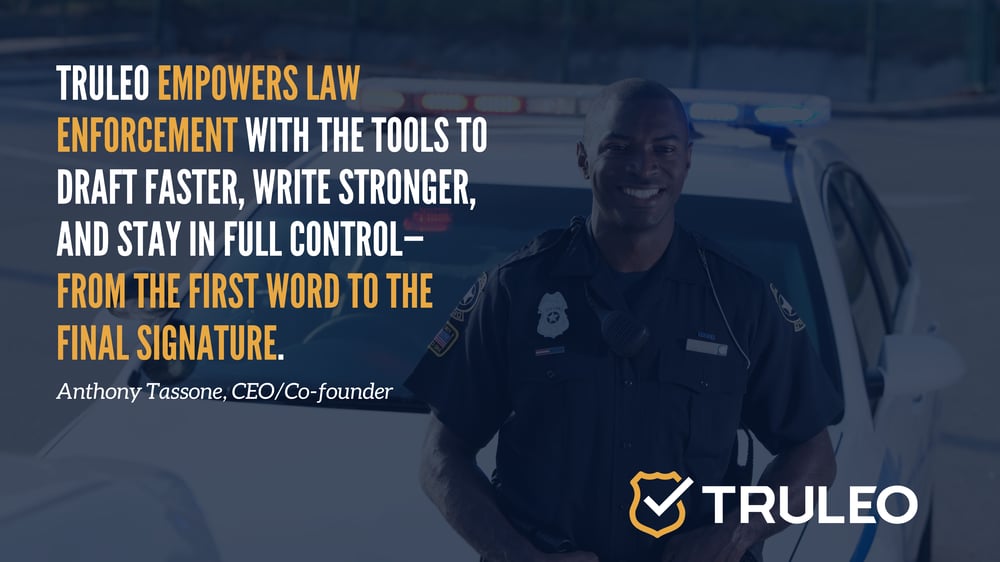New Study Uncovers Why 1000+ Departments Trust TRULEO's Reporting
AI report writing voice-generated reports Jul 24, 2025 9:00:00 AM Anthony Tassone 3 min read

A 2025 study published on CrimRxiv examined how early generative AI tools are being used in law enforcement—and the findings raise red flags. Among the most troubling? Some AI-driven report writing tools rely entirely on body-worn camera footage for the first draft narrative, which excludes officers from the input phase, and purposely insert errors to force human review. This backward “human in the loop” model doesn’t improve accuracy—it undermines it.
As agencies explore artificial intelligence police tools and report writing software, the stakes are too high to leave the first draft up to a machine. Officers must have full control over both the inputs and the outputs and have their perspective included. Because when AI gets the story wrong, lives, reputations, and justice itself are on the line.
Why Body-Worn Camera Footage Isn’t Enough
Some field report software promises to auto-generate incident narratives using only audio and video from body-worn cameras. But footage alone is not a substitute for the officer’s perspective. It doesn’t always capture the full context, tone, or reasoning behind an action. That’s why officers, and only officers, should define the facts of the case.
The CrimRxiv study reinforces this point. It found that AI systems built solely around BWC footage often produce content that’s factually incomplete or misleading. Even more concerning, some systems purposely inject mistakes or “hallucinations” into generated reports to force human engagement. The officer’s job becomes less about reporting—and more about policing the machine.
That’s not support. That’s a liability.
The Problem with “Review-Only” Human Oversight
Bringing in the officer only at the end of the process may check a policy box, but it doesn’t guarantee accuracy or ownership, and district attorneys hate it. Officers don’t have time to comb through pages of AI-generated text to ensure every detail is correct. And by the time they’re reviewing it, the report may be so far removed from what actually happened that they’re forced to rewrite it anyway.
This approach also assumes AI is capable of identifying the elements of a crime on its own. SPOILER ALERT: it’s not! Officers, not machines, are trained to distinguish between trespassing and burglary, between disorderly conduct and a threat. Automating those decisions is dangerous.
TRULEO’s Human-Centered Model
TRULEO flips the script.
With our report writing software, the officer is the primary author. They create the input by speaking, typing a note, and/or uploading case information. TRULEO’s AI assistant, TruAssist, steps in only to help: asking smart follow-up questions, tightening language, and making the officer’s draft stronger, not replacing it.
The difference is control. TRULEO’s field report software puts officers in charge of both the input and the output. Unlike our competitors, we don’t lock officers out of the first half of the process and then expect them to fix what the AI got wrong.
Reports come from the officer. TRULEO just refines and strengthens them.
Fast, Free, and Built on Feedback
We don’t just talk about officer empowerment—we build upon it. TRULEO’s platform is free for any officer to try, making it accessible to departments of any size. And our product evolves based on what officers need. If something isn’t working, or could work better, our U.S.-based engineering team responds fast. That’s because we believe the voice of the customer is more than just perspective; it’s our roadmap.
In a crowded market of AI tools built offshore or locked behind expensive contracts, TRULEO stands apart. We gain trust by being nimble, transparent, and responsive, and by putting officers at the center of everything we do.
Why It Matters
As the CrimRxiv study makes clear, deferring officer involvement until the end of the process creates risk: errors, misrepresentations, and erosion of trust. Artificial intelligence police tools should support the officer, not replace them. And report writing software should reflect the officer’s experience, not reinterpret it.
TRULEO empowers law enforcement with the tools to draft faster, write stronger, and stay in full control—from the first word to the final signature. The key here is to build professional and accurate, detailed reports so officers can save time in rewrites and sergeants are happy.
Try TRULEO today—for FREE—and see how real officer-led reporting is done!

Anthony Tassone
Anthony comes from a proud military and law enforcement family, built communication intelligence platforms (COMINT), and serves as a board member of the FBI National Academy Associates (FBINAA) Foundation. He travels the country teaching trusted law enforcement leadership organizations—such as FBI LEEDS—about the practical use of artificial intelligence in policing. He received his bachelor’s degree in Computer Science from DePaul University and lives in Greenville South Carolina with his wife and four kids and is an avid bowhunter, rescue diver and triathlete.